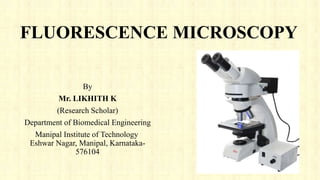The document provides an overview of fluorescence microscopy, detailing its principles, techniques, and key characteristics. It discusses the physical phenomenon of fluorescence, including the behavior of fluorochromes and their applications in biological imaging. Additionally, the document covers the historical development of fluorescence microscopy and its evolution over time.


































![In a wide field fluorescence microscope, the white light source is replaced by a high power lamp (a mercury or
xenon source), which excites the fluorochromes in the fluorescently labeled sample and induces fluorescence
emittance(Figure 5).
Images are typically acquired visually by eye or electronically with a CCD camera.
Fluorochromes have characteristic excitation spectra.
Thus, an appropriate excitation filter, usually a band-pass filter (BP), is placed between the lamp and the sample
to narrow the wavelength range of light reaching the sample to such an extent that the fluorochromes used are
excited efficiently, whereas unwanted excitation is minimized. (Figure 7)
Since the emitted light has a longer wavelength than the excitation light, an emission filter (either a long pass
[LP] or BP filter) placed between the sample and the detector effectively blocks the excitation light and prevents
perturbation of the final image.
Intense light is required for successful fluorescence excitation.
Lasers generally produce high intensity light and have proven to be an excellent alternative excitation source to
mercury and xenon lamps.
Since lasers are a source of monochromatic light, generally no excitation filter is required.
However an emission filter or an alternative spectral selection device is still needed to stop the excitatory laser
light from reaching the detector and to tune in on the fluorochrome’s emission signal, especially in multiple
labeling experiments.](https://image.slidesharecdn.com/fluorescencemicroscopylikhithk-211127065923/85/Fluorescence-microscopy-Likhith-K-35-320.jpg)









